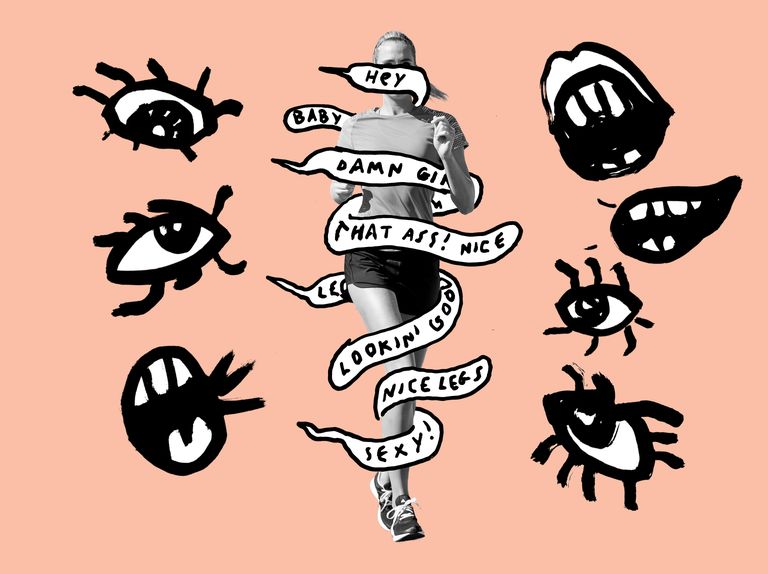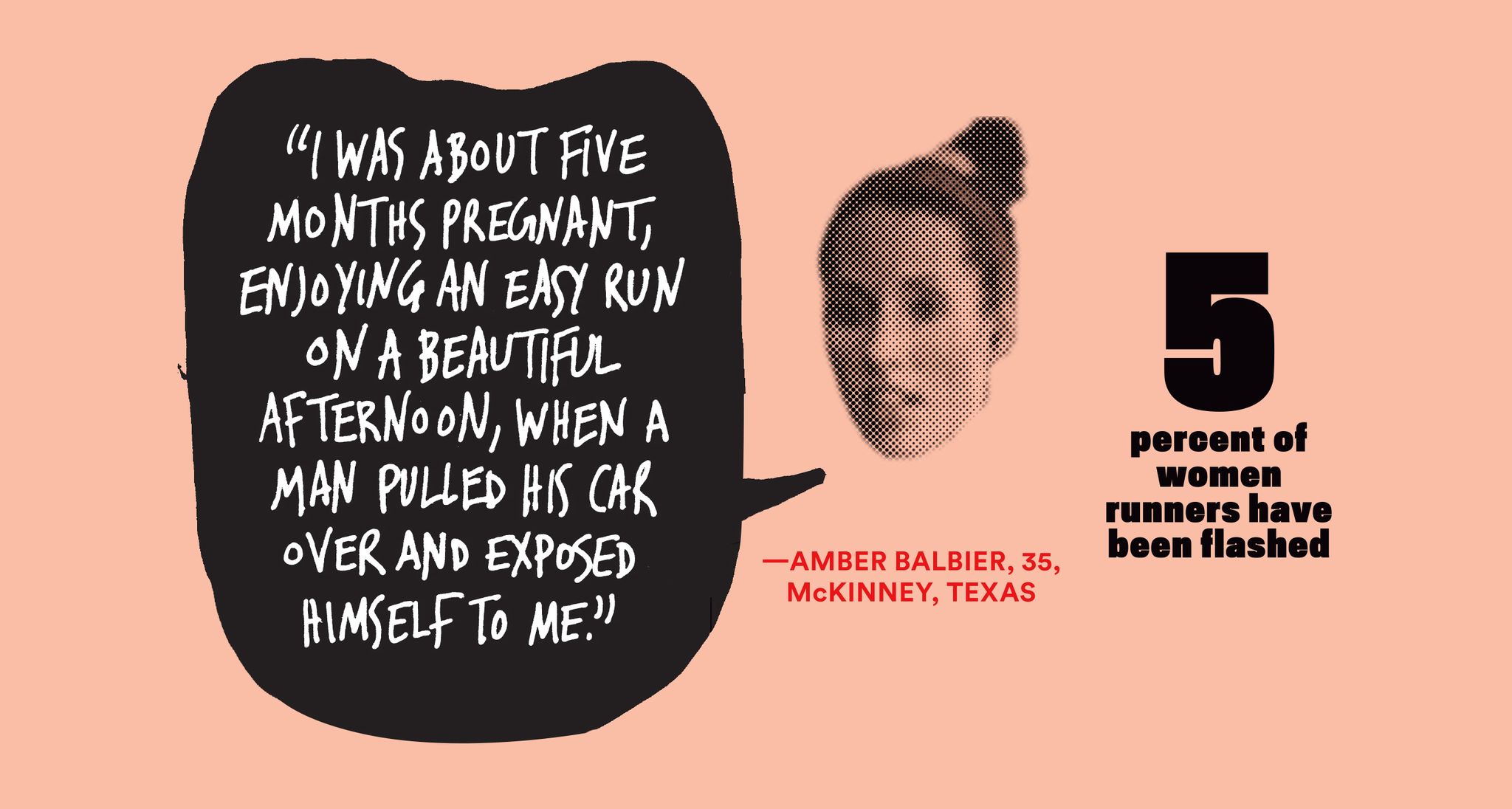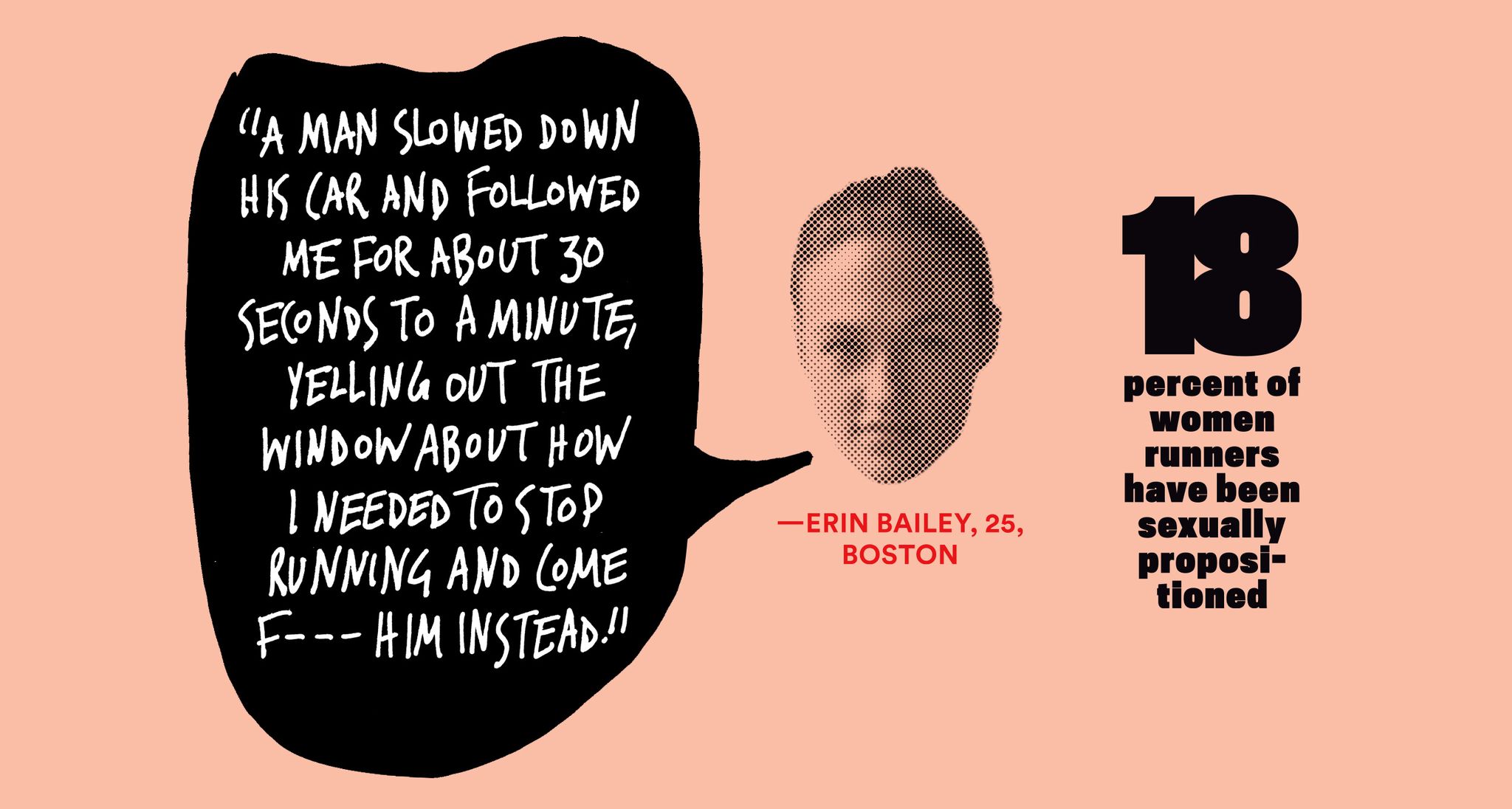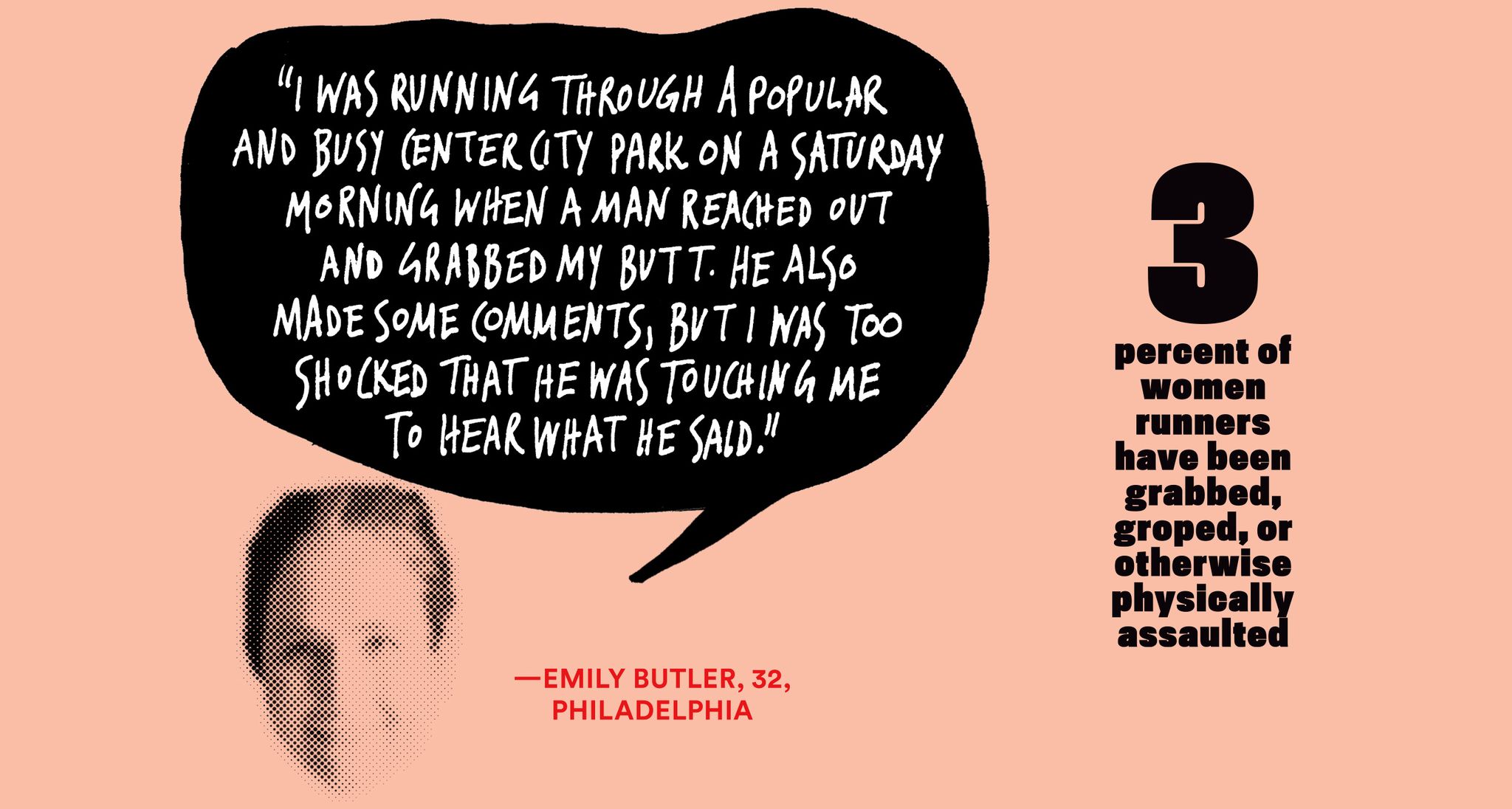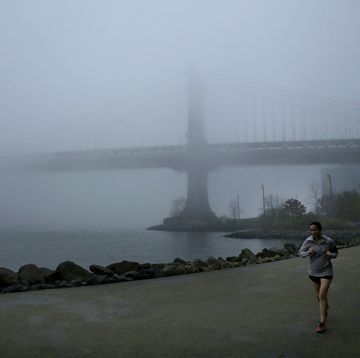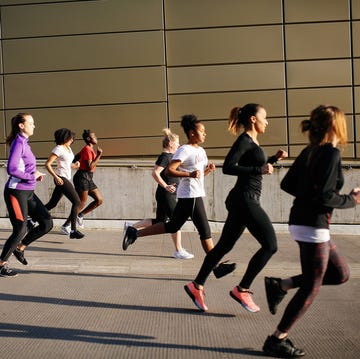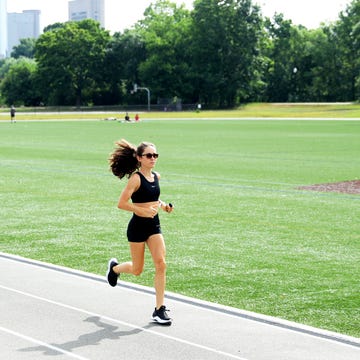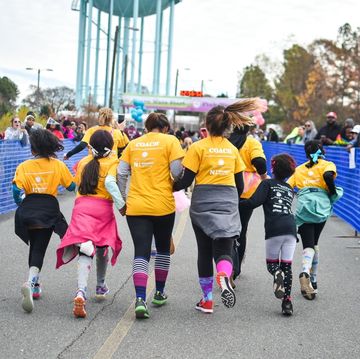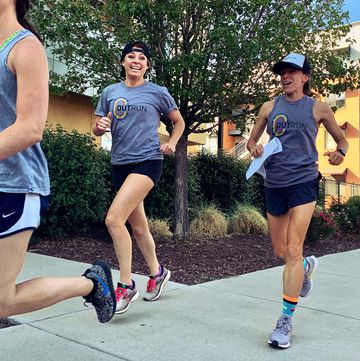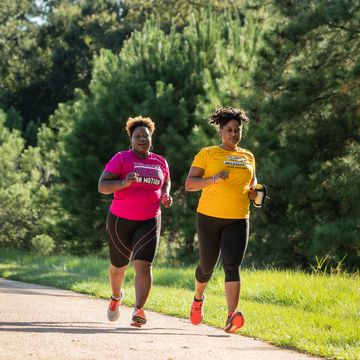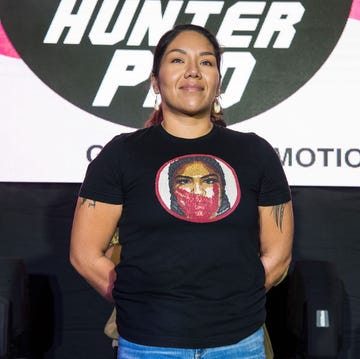When three young women were murdered midrun over a period of nine days this past summer, runners reacted with understandable shock, alarm, and concern. Nothing about the victims’ final miles should have been out of the ordinary: All three headed out in broad daylight. All three were on routes they’d traveled safely in the past. Their deaths occurred while they were running by themselves—one in Michigan, one in New York City, one in Massachusetts. But almost every runner trains alone sometimes. That such ordinary circumstances led to such unfathomable tragedy made these stories especially heartbreaking. More than two months have passed, and no suspects have been named in any of the three cases, which are likely unrelated.
As details of the murders spread in early August, well-meaning nonrunners started peppering the athletes in their lives (especially the women) with advice: Don’t run with headphones. Don’t run in the dark. Don’t run alone. Runners joined the discussion, too—some eager to share what they do or carry to feel safe, others dealing with a newfound sense of vulnerability. “Emotional stories about people we relate to have a strong effect on us,” says Jessica Gall Myrick, Ph.D., an assistant professor and researcher in media and emotions at Indiana University Media School in Bloomington, Indiana, and a former collegiate runner. When a person sees herself (or a loved one) in a victim, it’s easier to connect with the story, and the more similarities, the stronger the connection. Multiple cases intensify the reaction: “It can make you think the threat is greater than it really is,” says Myrick.
In reality, the chance of being murdered midrun is very, very small. A woman between the ages of 16 and 44 has only a 1 in 35,336 chance of being the victim of a homicide at any time. The risk for random homicide is even lower: A woman is far more likely to be killed by someone she knows than by a stranger. And she puts herself in far greater danger when she gets in her car to drive to school or work, when her risk of death is 2.5 times higher than by death at the hands of another person. The actual risk of dying in a car crash is 1 in 14,165—far higher than homicide at any time—yet random murders generate a disproportionate amount of anxiety.
Many runners (women as well as men) didn’t think twice about training alone before this past summer’s tragic, headline-making cases stoked their fears. Many still don’t. Those athletes may count on running to be a stress-reliever, an escape from everyday cares, a chance to feel free. Others have long felt more trepidation about logging miles solo—young women especially—because they are more likely to be interrupted in intrusive and sometimes frightening ways. Indeed, 43 percent of women at least sometimes experience harassment on the run, according to a recent RW survey, compared with just 4 percent of men. In the vast majority of cases, it’s not life-threatening. But it is pervasive, and it’s upsetting, and it’s most likely happening to you or someone you know.
A man will look a woman up and down as she runs past. A driver will shout a come-on, laughing with his friends as they speed away. A person on a bike or in a car will follow a woman, and she might dart down a side street to escape. Even if nothing like this happens most days, knowing that it (or something worse) could happen causes stress. As the recent national dialogue surrounding Donald Trump’s sexist comments and alleged assaults brought to light, almost all women—runners or not—have endured unwanted sexual attention. And no matter how swift a woman’s pace, it’s impossible to outrun harassment.
Your Wife, Your Friend, Your Teenage Daughter—She's Been Harassed
Of course, not every female runner has to deal with intrusive and unwanted attention on every single run, nor is every woman who laces up running shoes hypervigilant and scared. But some report especially high victimization rates: For women runners under 30, harassment is a frequent experience, with 58 percent in our survey saying it happens to them midrun always, often, or sometimes. And the more often she or her peers experience such intrusion, the harder it becomes to access the carefree headspace many runners pursue and perhaps take for granted.
Erin Bailey, 25, is on highest alert in the summer, when she runs outside several times per week. On a warm-weather four-miler this year near her home in Boston, she gave a thank-you wave to a parking attendant for stopping traffic so she could pass, and he responded by saying, “‘Mmm hmmm,’ like he was salivating over a steak,” she says. Jae Cameron, 30, of New York City endures stares and whistles so regularly on her work commute that she pauses at the door before she heads out on a run. Do I really want to go out there? she asks herself. Do I really want to go deal with this?
Bailey and Cameron live in big cities, and it’s true that urbanites are most likely to face unsolicited attention: Fifty-five percent of all city runners say they at least sometimes experience harassment on their runs. That’s a simple function of population density—the more people you see, the greater the odds one of them will act like a jerk. The converse is true, too—if you run in a quiet suburban residential neighborhood, you may not see anyone at all on your morning four-miler. Still, that means only runners who encounter zero pedestrians or vehicles are guaranteed an uninterrupted run. While rural runners are the least likely to report being targeted, those who endure it don’t benefit from the relative anonymity that larger communities provide. “There’s a high chance women in rural areas will see their harasser again,” says Holly Kearl, founder of the advocacy nonprofit Stop Street Harassment (SSH), “because they can’t avoid a store or run down a different road.”
It Sucks
Imagine running down the street, in the zone, and someone honks at you for no apparent reason. Your heart rate quickens, you start to sweat from alarm in addition to exertion, and you bristle at the fact that a stranger has disturbed your otherwise pleasant run. This time, picture the peace of a quiet country road…and how that peace might evaporate when a stranger driving a car slows down to tail you. Thirty percent of women who responded to our survey have been followed by someone in a car, on foot, or on a bike while running. Now imagine that your pursuer rolls down his window and asks if you’d like to [insert sexual act here]—a proposition like the ones 18 percent of women told us they’ve received midrun. Scary.
All of these scenarios, plus illegal behaviors such as flashing and groping, fall on the harassment spectrum. “Street harassment invades a person’s space and rights, like any form of sexual harassment,” says Debjani Roy, deputy director of New York City–based advocacy group Hollaback! Of the women RW surveyed who have been targeted midrun, 79 percent say it bothers them “a lot” or “somewhat.” And it’s not just annoying or inconvenient—a growing body of research shows chronic harassment can affect a woman’s confidence and exacerbate issues such as depression, anxiety, body-image concerns, and eating disorders.
Harassment reminds women that they’re vulnerable, robbing them of a sense of safety. Chelsea Cloud, 32, from Kalamazoo, Michigan, finds herself picking up the pace after an unwanted encounter. “If a harasser’s need is to take power away from women, then I will show how powerful I can be,” she says. But by the third incident—she once counted eight during a single run—she feels enraged and defeated. “I try not to let it get to me, but it does,” says Cloud. “Harassers are taking away my freedom and right to run outside in peace.”
Some women react by altering their running behaviors: Among RW survey respondents with concerns about safety or unwanted attention, 73 percent say those concerns have inspired them to run with a phone, 60 percent to limit their runs to daylight hours, and 52 percent to change running routes. “Women may choose to run more trails to get off the streets, but this comes with another set of dangers,” says Cloud. “Just last year, a young woman in my community was dragged off of the Bicentennial Trail in Portage, Michigan, and into the woods by a male attacker. Thankfully, she escaped and got help.”
Given this calculus—populated areas breed harassment, while remote areas can provide cover for potentially dangerous people—some women turn to the safety of the treadmill. In fact, 27 percent of women RW surveyed say concerns like these have driven them to run indoors at least once. In a national survey by SSH, 23 percent of women said they exercised at the gym instead of outside to avoid being victimized. Some women find even that’s ineffective: Boston-based runner Bailey eventually stopped going to her gym after a man there said her workout tights would look better off. “Running is supposed to be a release, a sanctuary,” she says. “Instead, I’m wondering if I’m going to be safe.”
WTF Are These Guys Thinking?
If a female friend were to tell you, “Some jerk said something disgusting to me while I was running,” you’d assume said jerk was a man—and you’d almost certainly be correct. Of the women who reported being harassed in the RW survey, 94 percent name men as the primary perpetrators. The forces driving these men are the same ones behind the gender-pay gap and the fact that calling women “fat pigs” does not automatically disqualify a political candidate in the United States: sexism and inequality.
“The public sphere is [still] a male space,” says Michael Kimmel, Ph.D., distinguished professor of sociology and gender studies at Stony Brook University in Stony Brook, New York. That’s why any woman who leaves her home for any reason—to run, to work, to get the mail—could potentially be harassed, and why this is not just a running issue but a societal one. Honks, innuendos, and so on are a man’s way of saying, “You are present in my space and I’m going to let you know it’s my space.”
This power play is present in the majority of unsolicited sexual attention, particularly when men are with other men, though not all men are conscious of it. “In a sex-biased culture, street harassment can become ingrained in male behavior,” says Shira Tarrant, Ph.D., a gender studies professor at California State University, Long Beach. Boys and teens model the behavior of the men in their lives, and if the adults objectify women or treat them with disrespect, the minors learn that it’s acceptable or even admirable.
Kimmel conducts informal polls with his students, and he says that while men or boys may think they’re whistling or catcalling to score a date, harassment really has little to do with romance, or even with women. “The real center of attention is a man’s relationship with other men,” he says. Men and boys want to look cool, be funny, or find validation and acceptance from other men. Society teaches that to be a man, you must be powerful, aggressive, and dominant, and some men apply that to how they treat women on the street. But this narrow definition of masculinity is only part of the problem, says Tarrant. A man’s own ego, self-esteem, and sexual or personal issues come into play, as well. This is one reason harassment can turn violent: If a woman exerts her authority by ignoring a guy or speaking her mind, the man may feel rejected or humiliated and act upon that anger.
Men who would never think of catcalling a woman can perpetuate inequality in subtle ways, often unconsciously. Some everyday examples include talking over women in meetings, soliciting ideas from only male colleagues, and dismissing another man’s bad behavior with an excuse like “some guys are just jerks.” When a woman runner shares a story of being targeted, asking her what she was wearing or whether she was alone implies that at least some of the blame might fall on her, when in fact the choice to harass belongs to the man alone. “I’ve been harassed in the dead of winter, completely bundled up with a mask covering most of my face,” Cloud says.
Where Do We Go From Here?
In the meantime, women deal with the possibility of being targeted by controlling the only factor they can: their own behavior. “I never run in the dark by myself, and when I am running alone during the day, I ensure that it’s in one of Denver’s busiest parks or in a well-populated area,” says Elizabeth Lemont, 22, of Aurora, Colorado. “I also try to switch up my routes so that no one could memorize where and when I go.” When harassment does occur, it’s hard to know how to respond. “I worry about men in cars trying to take retribution to my actions, so usually I don’t do anything,” says Tasha Coryell, 28, from Tuscaloosa, Alabama. But during a longer run, Coryell says, “I tend to react poorly and might glare or put up my middle finger—when I am really tired, I just can’t deal with it.”
The potential for offensive words to turn into actions is why some women carry protection; Kate Nyland, 36, of Brooklyn brings pepper spray on solo runs. “If I feel threatened, I simply hold it up—finger on the trigger—with a no-nonsense look on my face,” she says, adding, “I suppose this is confrontational, and it could backfire if the harasser is carrying a weapon.” While 21 percent of women tote pepper spray on their runs at least sometimes, a few women (1 percent) have gone to a greater extreme, carrying a loaded gun. Michele James, 34, a police officer in Enid, Oklahoma, started running with her handgun after she learned in her professional training that an attacker may be able to fight through pepper spray.
What a woman is wearing doesn’t protect her from being harassed, advocates like Kearl and Roy agree, but even so, there’s a widespread perception that the less you wear, the more likely you are to be targeted. “I never run in just a sports bra, which is sometimes unpleasant midsummer,” says Leslie Davis, 29, of Evansville, Indiana. Erin Bailey prefers to run in a sports bra and compression shorts in the heat, but sometimes will put on more and baggier clothing just to deflect comments. “I ask myself, Can I suffer through four miles in a shirt?” she says. “Yes? Okay, I wear a shirt. Can I do it for eight miles? No, that’s not best for my training.”
And that’s what nearly every young female runner has to do: find her own personal tipping point between feeling safe and comfortable, and feeling like she’s “giving in” to harassers. “While I think it’s important to tell people when they’re being predatory and sexist, the feeling of fear wins out every time,” says Olivia McCoy, 24, of Lexington, Kentucky. “But being harassed has nothing to do with me, where or when I’m running, or what I’m wearing; it’s about a person thinking that because I’m in public they have the right to make gross comments to and about me.” Lindsay Knake, 28, of South Lyon, Michigan, refuses to change her behavior. “If I cover up or stay inside, then I’m only cowing to the people who seek control over women. This behavior is not okay, and I believe we need to stand up to it.”
There’s no immediate, easy solution, because sexual harassment is a complex societal problem. But open and honest conversations about the issue—ones that include men as well as women—are a step in the right direction. “Too often, street harassment is normalized and minimized,” Kearl says. “Listening to people’s stories with empathy is important because these actions signal that street harassment is a serious issue.” Kimmel encourages men to speak up when they witness sexist treatment. “If I say nothing, even though I don’t like the behavior,” he says, “other men assume I support it.” Even if female runners can’t be entirely spared of harassment, disrupting the status quo is a place to start.
